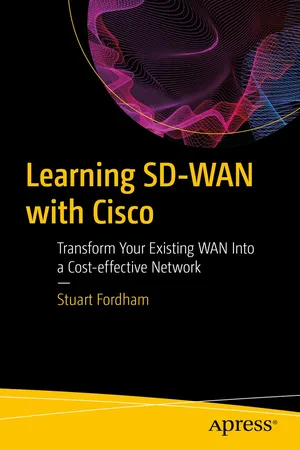
Learning SD-WAN with Cisco
Transform Your Existing WAN Into a Cost-effective Network
- English
- ePUB (mobile friendly)
- Only available on web
About This Book
Explore the rise of SD-WAN with CISCO and transform your existing WAN into an agile, efficient, and cost-effective network.
Learning SD-WAN with Cisco helps you understand the development of SD-WAN and its benefits to modern networks. This book starts with an exploration of the different components of SD-WAN, such as vBond for orchestration, vManage for management, vSmart for control, and the vEdge devices. From there, it moves on to building a network from the ground up using EVE-NG, focusing on how to install EVE-NG, get the required licenses via a SmartNET account, download the components, and begin to create your network by installing vManage.
Once you have this foundation, you will create the organization and certificates, and look at local users as well as single- and multi-tenancy options and clustering. As you continue to build your network, you will dig down into the overlay protocols used in SD-WAN, and then deploy your controllers and edgedevices, looking at zero-touch provisioning along the way.
After building your network, you will configure and apply policies and templates to manage the control and data planes as well as VPNs, Internet access, security, and quality of service. The book also explores reporting and management using vManage, along with upgrading and troubleshooting the various components, using techniques from simple ping and trace route through to advanced techniques such as DTLS and TLOC troubleshooting and traffic simulation.
After reading this book, you will have hands-on experience working with SD-WAN. You will understand how to deploy, configure, manage, and troubleshoot it.
What You Will Learn
- Know what SD-WAN is, how it came about, and why we need it
- Understand troubleshooting and traffic simulation ofDTLS and TLOC
- Monitor, report, and troubleshoot the SD-WAN environment
Who This Book Is For
Network professionals with experience in Linux and Cisco devices
Frequently asked questions
Information
Table of contents
- Cover
- Front Matter
- 1. An Introduction to SD-WAN
- 2. Deployment Overview
- 3. Deploying vManage
- 4. Understanding the Overlay
- 5. Deploying vBond
- 6. Deploying vSmart
- 7. Edge Devices
- 8. Templates
- 9. Routing
- 10. Policies and Quality of Service
- 11. Upgrades
- 12. Security
- 13. Management and Operations
- 14. Troubleshooting
- Back Matter